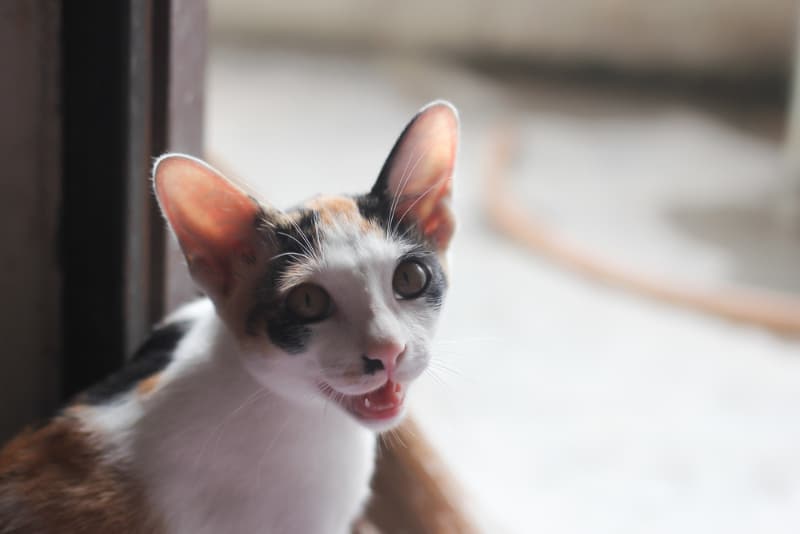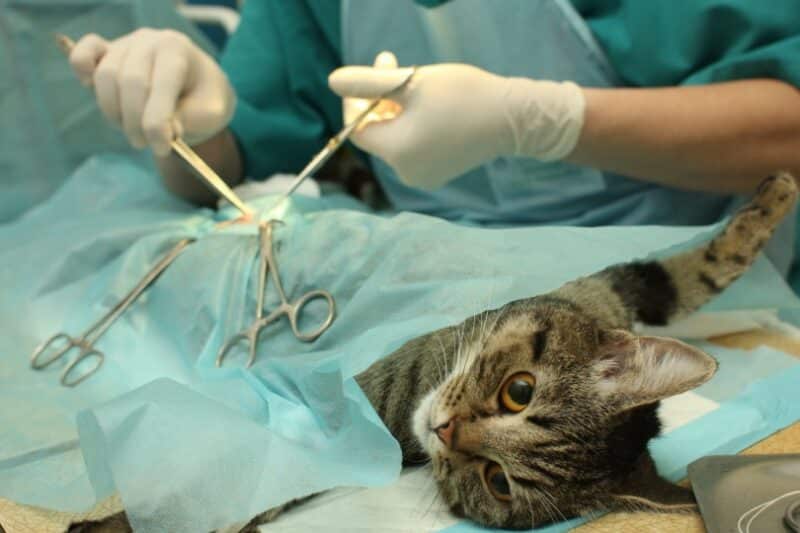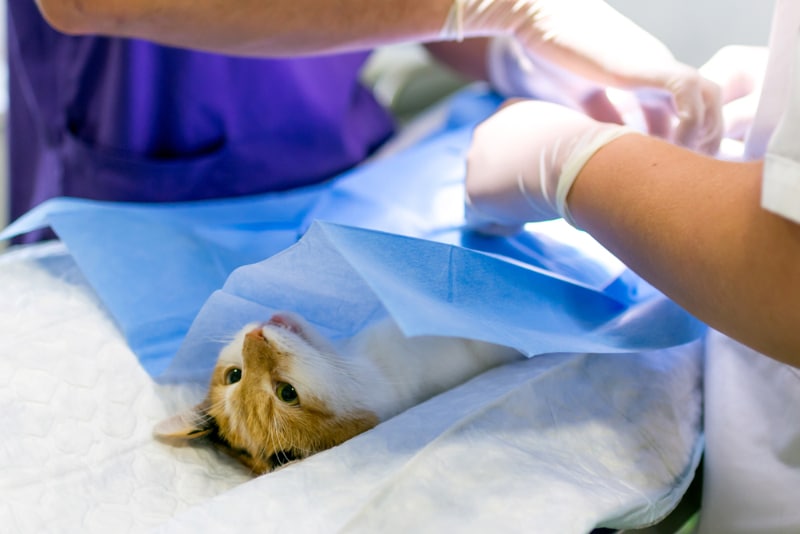You adopted your cat from a shelter, and she or he was already spayed. Now, a number of years later, she yowls and acts like she might be in warmth, however that couldn’t be attainable, proper?
You convey it as much as your vet throughout your cat’s semi-annual bodily examination, they usually recommend that your cat may have ovarian remnant syndrome. Let’s dive into what that would imply and what to do to your cat.
Click on Under to Leap Forward:

What Is Ovarian Remnant Syndrome?
Ovarian remnant syndrome is a situation the place there’s nonetheless some ovarian tissue left within the stomach after a vet has spayed your cat. This situation can even happen in canine.
You may discover that your cat is exhibiting indicators per being in warmth or estrus. Whereas they will’t get pregnant, affected cats could also be interested in males. Your veterinarian will study your cat and recommend particular assessments to verify a analysis of a retained ovarian remnant.
Usually, this situation happens as a result of a bit or a complete ovary is left inside your cat’s stomach throughout the spay process. Some cats can have ectopic ovarian tissue, which is ovarian tissue in an irregular place inside the physique.

What Are the Indicators of Ovarian Remnant Syndrome in Cats?
As a result of cats with retained ovarian tissue expertise hormone cycles, they’ll present indicators much like an unspayed feminine. Curiously, it may possibly take years for a cat to indicate indicators of a retained ovarian remnant. In accordance with the Animal Surgical Middle of Michigan, affected cats will present indicators of a warmth cycle a median of 15.5 months after spaying. As well as, roughly 17% of spay problems contain ovarian remnants.
Widespread indicators of a retained ovary are bloody discharge out of your cat’s vulva and an enlarged or swollen vulva. As a result of cats are avid groomers, you might not see both of those indicators in your cat.
One other signal of estrus in cats is elevated vocalization. Your ordinarily quiet cat could yowl repeatedly. They will also be more and more stressed. You probably have an intact, unneutered male cat, your feminine could enable or encourage copulation, however they won’t be able to get pregnant.
Secondary to hormone modifications, your cat’s mammary glands and nipples could enlarge.
What Are the Causes of Ovarian Remnant Syndrome in Cats?
The commonest explanation for ovarian remnant syndrome in pets is surgical error. The surgeon leaves a portion of the ovary remaining after surgical elimination of the ovaries throughout a spay. This complication could also be a bit extra frequent in cats than canine as a result of it may be more durable to visualise the entire ovary because it’s more durable to interrupt down the right ligament in cats than in canine.
One other potential trigger is ectopic ovarian tissue. This trigger pertains to ovarian tissue not being positioned in a traditional place in your cat’s stomach. As an alternative of its ordinary location inside the ovary, some ectopic tissue might be present in locations just like the broad ligament. In case your veterinarian doesn’t detect this ectopic tissue throughout surgical procedure, it will get left behind and turns into an ovarian remnant.
The remaining tissue turns into hypertrophied after some time and continues to secrete reproductive hormones, resulting in indicators of estrus.
You do must be cautious about sure drugs as a result of they will additionally mimic your cat having an ovarian remnant. Should you use a topical estrogen cream and your cat can contact or lick it off, they will current like your cat is having a warmth cycle.

Diagnosing Ovarian Remnant Syndrome in Cats
Your veterinarian could have a robust suspicion that your cat has ovarian remnant syndrome, nevertheless it ought to be confirmed via testing earlier than any intervention.
First, guarantee there’s no probability that anybody has uncovered your cat to topical estrogen or progesterone.
Your veterinarian could carry out vaginal cytology to search for mobile modifications per a warmth cycle, most notably cornified vaginal epithelial cells.
The very best help for ovarian remnant syndrome is utilizing two hormone assessments.
- Progesterone ranges ought to be decrease in a spayed feminine.
- Anti-müllerian hormone ranges ought to be checked. A constructive check signifies that ovarian tissue is within the cat, whereas a adverse check means it isn’t.
How Do I Look after a Cat With Ovarian Remnant Syndrome?
Sadly, in case your cat has ovarian remnant syndrome, they’ll want surgical procedure to take away the remaining ovarian tissue. Some veterinarians can carry out this surgical procedure laparoscopically, the place your vet will make a sequence of small incisions and use a digicam to establish the tissue.
Typically, your veterinarian will carry out an exploratory surgical procedure to establish the retained tissue. The process is finished the identical means as your cat’s preliminary spay.
After surgical procedure comes the exhausting half: protecting your cat quiet and calm for about 10 days. You probably have a really lively kitty, your veterinarian may prescribe sedatives to maintain them calm.
Gabapentin could also be used as a ache remedy and a gentle sedative. They’ll additionally usually obtain pain-relieving anti-inflammatory remedy, akin to Onsior (robenacoxib).
As exhausting because it may be, your cat ought to put on an Elizabethan collar (e-collar, for brief). This often inflexible “cone of disgrace” will help preserve your cat from licking or chewing at their incision, which may trigger it to grow to be infected, contaminated, and even reopen. Some cats do nicely with a bodysuit, so discuss to your vet about what possibility may work greatest to your cat.


Regularly Requested Questions (FAQ)
How frequent is ovarian remnant syndrome in cats?
Ovarian remnant syndrome is just not a standard prevalence after a spay, nevertheless it does look like extra frequent in cats than canine. Of post-ovariohysterectomy problems, lower than 20% are retained in ovarian tissue.
One research checked out pre-surgical variables to see if something was frequent to reviewed instances. The age of the pet and its breed weren’t important elements. Curiously, even weight problems didn’t enhance the chance of a cat having ovarian tissue left behind.
Can ovarian remnants grow to be cancerous?
Ovarian remnants have the potential to grow to be cancerous, at the least in people. We do know that, in pets, retained ovarian tissue might be linked to a number of cancers growing exterior of the ovaries, akin to mammary most cancers (akin to mammary gland adenocarcinoma) and vaginal most cancers
Your cat can be at the next threat for growing a uterine stump pyometra, an an infection inside the remaining portion of the uterus.

Conclusion
Ovarian remnant syndrome can happen in cats because of poor surgical approach, bother exposing the ovaries throughout an ovariohysterectomy, and even further ovarian tissue in an irregular place inside your cat’s physique. Your veterinarian will associate with you on surgical procedure or refer you to a facility for laparoscopic surgical procedure.
Featured Picture Credit score: megaflopp, Shutterstock



